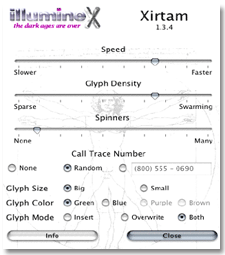This screen saver displays the "Xirtam Code", random green text which falls down the screen continually. It attempts to duplicate an effect seen in a popular movie.
"Speed" controls the screen saver's attempted frame rate and ranges from 10 to 100 frames per second. Of course, the actual frame rate achieved will depend upon your computer's ability to keep up. As such, you may not be able to get a full 100 frames per second even if you request it. Setting the speed lower will use less CPU, which may be important if you are running background processes such as SETI@home or a web server. The default setting is 75 frames per second.

In this screen saver there are seven parameters available to you, "Speed", "Glyph Density", "Glyph Size", "Glyph Color", "Glyph Mode", "Spinners" and "Call Trace Number".
"Glyph Density" controls how many text characters (glyphs) are on the screen versus empty black spaces. The higher the value of this slider, the more text and the less black space you will see.
"Glyph Size" controls the size of the text characters. There are two available sizes, big and small. The larger glyphs show more detail, but fewer of them fit on the screen. They also appear to move down the screen faster than the small glyphs for any given frame rate.
"Glyph Color" controls the color of the text that is drawn. Only two colors, the standard green and an icy blue, are available for the big glyphs. Two additional colors, purple and a brownish orange, are available for the small glyphs.
"Glyph Mode" controls how the glyphs are drawn. In insert mode, the glyphs actuall appear to fall or slide down the screen. New glyphs are inserted at the top and push the other glyphs in the column downward. In overwrite mode, the new glyphs are drawn from top to bottom, replacing the existing glyphs. A given glyph never moves, it just gets replaced over time. If you choose to use both, then both approaches are used, chosen at random. This gives an effect closest to what is seen in a certain popular movie.
"Spinners" limits how many spinners appear on the screen at a given time. A "spinner" is a glyph which does not move from its position on the screen, but is constantly changing the actual glyph it displays. The number of spinners set by this slider is only a maximum. You may not get the expected number of spinners, especially at low glyph densities.
"Call Trace Number" controls the tracing mode at the beginning of the screen saver. If turned on, then before the falling green text begins, the screen saver will "trace" a phone number. Random numbers will appear until the traced number is complete. There will be a pause for a few seconds after the traced number is displayed, and then the falling text will begin. If you choose "none", then this mode is turned off. "Random" will choose a new, randomly selected number each time the screen saver starts. You can also choose to provide any phone number you wish to have appear at the end of the trace.
The Xirtam screensaver module shares algorithmic ideas with the "xmatrix" screen saver by Jamie Zawinski, but has a completely new, Objective-C based source tree. In order to achieve a higher frame rate, we have completely replaced the drawing portion with an Open GL based approach. The better your hardware 3D acceleration, the faster this screen saver will run.
